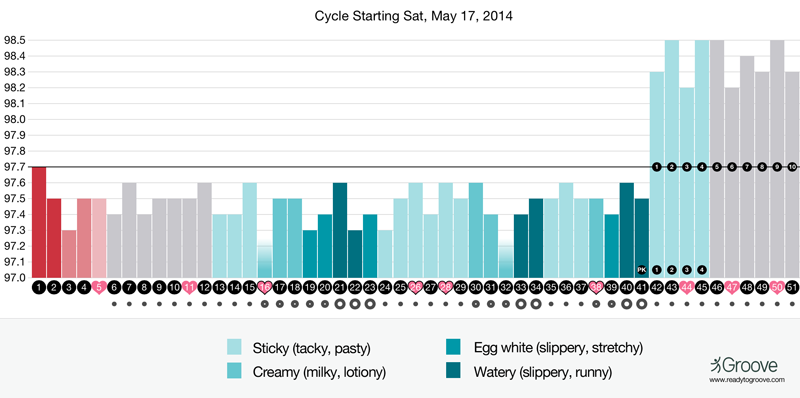Charting Fertility with Polycystic Ovarian Syndrome (PCOS)
Dealing with highly irregular menstrual cycles is crazy frustrating. Your periods, when they do decide to come, can sneak up on you at the most inopportune times. Not just that, but irregular cycles are often an indication of a reproductive disorder like polycystic ovarian syndrome (PCOS) and can cause difficulty getting pregnant, acne, weight gain, and very long cycles, among other things. It’s no wonder that so many women with PCOS and other cycle irregularities opt to use hormonal contraceptives to provide some predictability among all the madness.
For those who may not want to go the hormonal route, for those of you thinking about getting pregnant, or for those who want to take steps to get your cycles under control, there are other options. Charting fertility using the sympto-thermal method of fertility awareness can help with each of these things and, additionally, help you make sense of what’s going on downstairs. With SO many women these days struggling with PCOS (as many as 1 in 10), it’s more important than ever to learn about your options.
PCOS, at its most basic level, is an imbalance of hormones that causes very long cycles due to the body’s unsuccessful efforts to ovulate. Ovulatory menstrual cycles are characterized by a cocktail of hormones produced before ovulation and another produced after ovulation. Before ovulation, hormones cause the cervix to secrete an increasingly wet and slippery fluid that aids in sperm survival. A woman with PCOS may notice that this cervical fluid, or cervical mucus, progresses from sticky to slippery several times before ovulation actually occurs.
These waves of fertile fluid are called “false peaks” when they aren’t directly followed by ovulation. Once ovulation does occur — which can be confirmed by a sustained rise in basal body temperature — your cycle will behave very much like a woman who does not have PCOS. The luteal (or post-ovulatory) phase of the cycle will be a very consistent number of days (usually between 12 and 16 days), even for those of you who do have highly irregular cycles.
Tracking changes in cervical fluid lets you know when your body is ramping up to ovulate and when you are potentially fertile. Even though your body may not successfully ovulate on the first try, you should consider yourself fertile when any cervical fluid is present in the follicular (or pre-ovulatory) phase. Measuring basal body temperature is useful because it informs you when (and if) you are ovulating.
Once you do confirm ovulation — even if it happens three months after your last period — you’ll know exactly when to expect your next period. This is why charting cervical fluid (cervical mucus) and basal body temperature is so great! Charting helps you figure out what’s happening with your cycle and can eliminate a lot of the frustration that comes with having PCOS. I’ve included a sample chart below to help you visualize what a PCOS cycle might look like.
This woman experienced two separate “false peaks.” Her first false peak occurred on cycle day 23 and the second on cycle day 34. Her third wave of cervical fluid finally resulted in ovulation, so her true peak day occurred on cycle day 41.
If you’re charting to prevent pregnancy, always use a barrier back-up when you notice cervical fluid because there’s no way of knowing whether the current hormone surge will result in ovulation. If you’re charting to get pregnant, make sure to time sex when you notice slippery fluid, again, because there’s no way of knowing whether the current hormone surge will be the one that triggers ovulation. If you’re trying to get your PCOS under control by making lifestyle changes, charting will help you visualize how your cycle is being affected by the changes you’re making.
If you are charting to get your PCOS under control, a good rule of thumb is to alter only one or two minor things about your lifestyle at a time so you’ll know for sure whether it’s making a difference. I’m definitely guilty of this mistake. I started taking a bunch of vitamins, altered my diet, and upped my activity level all at the same time…so I had no clue what was helping and what was completely unnecessary. Talk about stressful! Lifestyle changes won’t work overnight, either, so make sure to give yourself a few months before you decide that something isn’t helping.
Taking it slow will require a lot of trial and error (and some major patience), but it’s definitely worth it if you get positive results. My friend Nicole Jardim, a Certified Women’s Health Coach and all-around awesome lady, has several wonderful programs to help you Fix Your Period that I would highly recommend. She’s helped me out with period woes on several occasions. I also highly encourage you to check in with your doctor before starting supplements or work with a fertility awareness educator if you need help with charting.
When you have PCOS, charting your fertility isn’t always an easy feat. At first, it may be frustrating and riddled with expletives, but it can also be chock full of useful, empowering information about your unique body.

